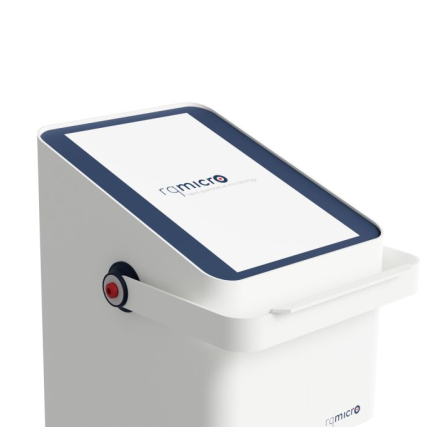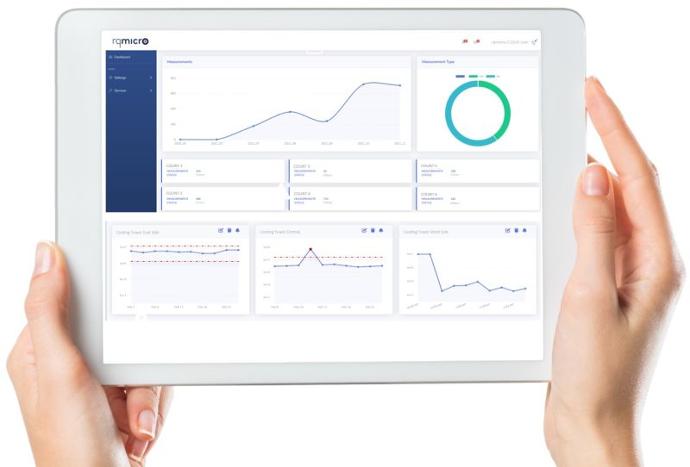Quality control managers and process engineers must regularly and accurately test and monitor critical water systems to ensure the microbiology in these systems remains under control. These use cases can pertain to food & beverage production, land-based aquaculture systems, cooling towers, wastewater reuse, and in many other applications.
Once this critical water testing data is collected, it often must be shared, to:
- Eliminate the risk of outbreaks
- Benchmark processes and facilities
- Showcase success and compliance
But data sharing requires clear, exacting controls and security measures to ensure the information is only seen by approved individuals or teams. Therefore, the ideal water monitoring systems combines both of these elements:
- An accurate, reliable and fast water testing system
- A secure, access-controlled cloud-based sharing environment
rqmicro’s Cloud Solution, a software-as-a-service (SaaS) offering that complements the rqmicro.COUNT instrument for a rapid microbiological water analysis was developed exactly with these two core needs in mind. Together, they present a comprehensive platform for microbial monitoring, and it is used in a wide variety of applications and industries. Download our case story to see how the Cloud Solution became part of everyday business by integrating with one aquaculture’s general control tool.
Let’s break down the reliable testing and secure sharing platforms further.
Part I: For Bacteria Detection, Go with the Flow (Cytometry)
Of all water contamination testing processes, flow cytometry, the technology deployed in rqmicro.COUNT, is considered a superior method due to several advantages it offers over traditional culture-based methods.

Key reasons include:
- Rapid and High-Throughput Analysis: Flow cytometry allows for rapid and high-throughput analysis of water samples. It can quickly measure and analyze thousands of individual particles or cells per second, providing a more comprehensive assessment of microbial populations in a relatively short time. This speed is especially crucial for detecting and responding to potential contamination events promptly.
- Quantitative Analysis: Flow cytometry provides quantitative data by measuring individual microbial cells or particles based on their size, shape, and fluorescence properties. This quantitative analysis allows for accurate enumeration of microbial populations, providing a better understanding of contamination levels and changes over time. In contrast, traditional culture-based methods can be subjective and limited in quantifying viable but non-culturable (VBNC) or injured microorganisms.
- Detection of Viable but Non-Culturable (VBNC) Cells: Flow cytometry can detect and analyze VBNC cells, which are microorganisms that are alive but cannot grow on standard culture media. VBNC cells may still pose a risk to water quality and public health. With flow cytometry analysis, it is possible to differentiate between viable and non-viable cells, thus capturing a more accurate representation of microbial contamination.
- Real-time Monitoring: Flow cytometry can be used for real-time monitoring of water quality. Continuous or periodic monitoring using flow cytometry provides timely information on microbial population dynamics and changes in water quality. This real-time monitoring capability allows for immediate response and intervention when contamination events occur, reducing the potential risks associated with delayed detection and response.
- High Sensitivity: Flow cytometry is highly sensitive and can detect low levels of microbial contamination in water samples. It can find microbial cells at concentrations as low as a single cell per milliliter, providing early warning signs of contamination before it reaches critical levels. This sensitivity is crucial for preventing the spread of microbial contaminants and minimizing potential health risks.
- Automation and Standardization: Flow cytometry can be automated, allowing for standardized and reproducible analysis of water samples. Automation reduces human error and ensures consistent analysis across different samples and laboratories. The availability of standardized protocols and quality control measures further enhances the reliability and comparability of flow cytometry data, promoting accuracy and consistency in water quality assessment.
But, as mentioned above, collecting accurate water testing data is only half the story.
Part II: Cloud-based Data Sharing
The other challenge—sharing water testing data in a secure, controlled cloud-based environment—is a critical aspect of managing the risk of the microbial contamination for various use cases.
The Cloud Solution offers a readily accessible toolbox for effortless organization of microbiology data and seamless presentation of relevant information to stakeholders.

- Controlled, confidential access. Quality control managers and process engineers can ensure robust data protection and access control with the Cloud Solution. Raw data and reports are safeguarded through comprehensive user administration settings, allowing precise control over user access to critical results.
- Customizable dynamic dashboard. Structured, intelligent data is more than numbers. It’s insights. Cloud Solution lets you build your own dashboard to generate actionable, real-time insights with interactive data visualizations for allowing your organization to focus on priority findings.
- Streamlined data analysis. Customization is vital as each business and operation varies, and rqmicro's Cloud Solution excels in providing a data sharing platform that enables users to assign predefined tags, add comments, and group results by parameters like CCPs, cleaning measures, or maintenance procedures.
- Export in multiple formats. One size does not always fit all. As such, your output data should be able to come in various formats (such as Word, Excel, CSV and json) and downloaded within built-in templates to saving you and your stakeholders time. And for those running broader data visualization platforms, you should be able to easily integrate data from the cloud platform with your own.
Discover the full range of benefits offered by the rqmicro platform, providing a reliable and comprehensive solution for operators in the industry. Learn more about rqmicro’s Cloud Solution.